The Legend of Zelda is a video game franchise which has released games for over 3 decades. Over the years there

have been many theories regarding individual games, or the series as a whole, that fans have speculated upon.
The Legend of Zelda Ocarina of Time/Majora Mask Theory - Link is Dead[]
There is a popular theory regarding The Legend of Zelda Ocarina of Time and Majora's Mask, which states that the Link

Game Theory Is Link Dead in Majora's Mask?-0
from Ocarina of Time is not in fact the same Link as in Majora's Mask, and that he is in fact dead; this link supposedly became a Skull Child, and is the Skull Child constantly tormenting the Link in Majora's Mask. This theory is further supported by the fact that Link constantly traveled through the Lost Woods, and children who get lost in the Lost Woods become Skull Children if they're not the Kokiri, which Link is not, he's a Hylian. Another theory is that he was killed when he was thrown off his horse, Epona, at the beginning of the game.
Majora's Mask - Five Stages of Grief Theory[]
Skull Kid & Majora's Mask[]
Link’s antithesis throughout these proceedings is the Skull Kid. We hear from one of Grandma’s stories that Skull Kid, as the "imp," was once the friend of the Four Giants, but when faced with the prospect of losing them to their slumber in the four corners of the world, he fell into deep despair. In his grief, he tormented the peoples of the four lands, and as a result lost his friends. That same grief gets absorbed by Majora’s Mask as it feeds off of Skull Kid’s emotions. As a result, when Link faces Skull Kid at the top of the Clock Tower, it manages to take on a life and personality of its own, creating a psychological dimension in which Link must face it in one final showdown.
By surrendering the masks he's collected on his journey - in essence providing proof of his battles against grief - Link earns the Fierce Deity's Mask, which is described as "containing the merits of all the masks." That this mask transforms Link into an adult form in contrast to Majora’s Mask’s own child-like form signifies the maturity he has gained by overcoming grief. That maturity gives him great power, with which he can easily vanquish the comparative weakness of grief and despair.
Taken out of the shadow of grief, we see that Skull Kid is able to reconcile with his old friends and find peace in their departure. But we also see that this parting is not the end. As the story closes, we note that he has returned to the Lost Woods together with Link, his new friend.
About Themes in Motion[]
Themes in Motion was an article project I started up a little over a year ago, aimed at exploring the thematic elements packed into each story in The Legend of Zelda series. I’ve already carved my way through all of the games, but for Majora’s Mask‘s birthday I wanted to give it a special second look. The idea that Majora’s Mask is a trip through the five stages of grief is not my own original conception, but it’s one that I find tremendously profound and I hope I’ve done it some justice.
Clock Town - Denial[]
Link arrives in Termina through the Clock Tower, which ticks ever onward in its countdown to the Carnival of Time, the great festival that comes each harvest time. As the people live out their everyday lives, running errands, making appointments, and setting up for the carnival, an ominous Moon looms overhead, threatening to crush the whole land.
Because of his Deku Scrub form, Link is confined in terms of where he can go and what people are willing to tell him, but a visit to the Mayor’s office reveals an important struggle brewing just beneath the surface of all the goings-on:
You cowards! Do you actually believe the moon will fall? The confused townsfolk simply caused a panic by believing this ridiculous, groundless theory. The soldiers couldn’t prevent the panic, but outside the town walls is where the danger is! You want answers? The answer is that the carnival should not be canceled!
If the soldiers wish to run, then run, Viscen! We councilmen will stick to tradition. This carnival will be a success! I’ve never heard of a defense unit abandoning its town! -- Mutoh the Carpenter
What seems like a petty squabble between bureaucrats we can actually interpret as a metaphor for denial. The Carnival Committee, unwilling to acknowledge and account for the looming danger, choose to ignore it rather than deal with it. They laugh openly at the idea that the moon will fall, and refuse to allow it to interfere with the Carnival. Similarly, the master at the sword training center entertains the idea that if the Moon comes too close, he can simply cut it to pieces with his blade. In both cases, we see an inability to grasp the reality at hand and foolish fantasies arising to take its place.
The denial can only ever be temporary, however. Eventually most of the Carnival Committee is forced to face the music as the Moon, drawing ever closer with each passing hour, gradually becomes more and more difficult to ignore. By the night of the third day all of the carpenters and merchants have evacuated, leaving only Mutoh and all his stubbornness behind. The sword-master has retreated to a back room, where he lies trembling in fear and despair.
In contrast, Link spends his every waking hour in pursuit of the Skull Kid in the hope that he can retrieve his Ocarina of Time before it’s too late. By midnight on the third day, his efforts have brought him to the top of the Clock Tower, where he stands face-to-face with the giant Moon. But, armed as he currently is, he has no way of stopping it, and in the end he too is forced to enact a sort of denial by using the Song of Time to reverse the flow of time, undoing the events leading up to the great fall and giving himself a second chance to set things right.
Woodfall - Anger[]
When Link arrives at the Deku Palace at the heart of the Southern Swamp, he discovers another case of grief: the Deku Tribe’s princess has gone missing. As he inquires about the situation he meets the leader of the tribe, the Deku King, a rather ridiculous despot hell-bent on punishing a young monkey, whom he believes has made off with his daughter and fed her to monsters in Woodfall Temple.
We’re about to punish the foolish monkey who kidnapped the Deku princess! He has insulted the Royal Family. I’ll show him what happens when you do that! That foolish monkey is up in that cage. Take a good look at his face! -- Deku King
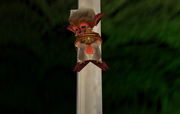
There’s one glaring problem with the proceedings, however - the monkey is completely innocent. In fact, when the princess went missing he was working together with her to investigate the source of the vile swampwater flowing forth from the temple. Rather than putting his energies at work in search of the princess, he instead takes his anger out on the poor monkey. The real villain at work is anger - the evil sown by the Skull Kid, manifesting in the cursed swamp, the toxic rifts that divide us in moments of rage, and the fury and might of the Deku King himself.
Link tasks himself with diving deep into the temple in order to purify the swamp and rescue the princess. To get inside, however, he needs to learn the Sonata of Awakening, which has the power to lift the temple from its resting place beneath the bog. The image of the temple rising out of the infested waters exemplifies the casting off of ill emotions, and the mad warrior demon Link defeats at the core of the temple signifies the inner struggle between controlled and uncontrollable moods.
In the end Link manages to pacify that anger, snapping the Deku King back to his senses and freeing both the region and the monkey from what would otherwise have been torturous fates.
Snowhead - Bargaining[]
Link’s next trip takes him north, into the high, snowy mountains of Snowhead. There he encounters the Gorons, another tribe in mourning due to the recent loss of their patriarch, Darmani. After some careful investigation, Link meets Darmani’s ghost, who beckons for him to give pursuit. Above Darmani’s grave, the deceased Goron hero delivers his last request:
As I am, I can only watch as Goron Village is slowly buried in ice…I may have died, but I cannot rest. So, you can use magic? The soaring one also told me that you are able to use it… I beg you! Bring me back to life with your magic! -- Darmani's Ghost
Darmani’s futile hope to be brought back to life is a textbook example of bargaining. Unable to face his failure or his people in order to find closure, he turns to magic as a means of undoing his death in order to finish his battle with the demon. In a way, we can see bargaining as a sort of second denial, no longer fueled by anger but instead by foregone hope in the face of fear.
Just as Clock Town’s denial was represented by the elephant in the room that was the falling Moon, and the divisive anger of Woodfall was thematically shown in the toxic sludge infesting the Southern Swamp, the bitter, paralyzing cold of Snowhead exists as a mirror of Darmani’s inability to move on. Only once doused with the refreshing heat of Hot Spring Water and pacified from his desperate desire to see his dying wishes through is he able to find his resting peace - a peace symbolized by the Gorons’ Lullaby.
In Darmani’s guise, Link conquers Goht, a mechanical bull of sorts that moves constantly in a circuit around his arena, unstoppable except by the strength of a Goron hero. Goht for us represents a futile, circular effort to claw one’s way back to a reality that is already lost. By defeating him, Link puts an end to the demon’s seemingly-endless romp, just as Darmani is able to rest in peace only by bringing his hopeless desire to keep on living to a grinding halt.
Great Bay - Depression[]
Link meets the dying Mikau on the coastline of Great Bay, where he learns about the guitarist’s girlfriend, Lulu,
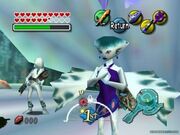
and her missing eggs. Though Mikau’s passing would by itself be plenty of cause for grief, with the Zora Mask Link is able to assume the part-time musician, part-time hero’s life seamlessly, as though he has never left. This nonetheless leaves Lulu in isolation, gazing out to the Great Bay Temple from the outside of Zora Hall. Her isolation reflects depression, the fourth stage of grief.
Because Mikau’s death is more or less irrelevant thanks to Link’s ability to take on his form, we know that Lulu’s seclusion must have something to do with her missing eggs. We can infer that her maternal relationship to the eggs probably only serves to heighten her low emotional state. That she seems to have only recently laid the eggs also suggests a possible postpartum dimension to her depression. And, just as the other regions served as apt images of their corresponding grief stages, we can see the Great Bay as a collection of Lulu’s spilled tears.
Only by singing the tune born from her offspring, by reestablishing a connection to what was lost through vocal expression, can Lulu come out of her slump. In a way we can make yet another comparison to a type of maternal depression - that experienced by young mothers who have miscarried. The act of naming the lost child can lead to a sense of closure. Here, the act of singing - each note representing one of the eggs - accomplishes the same.
Inside the Great Bay Temple, Link also works to reconnect - though for him this is about redirecting water flow through the various pipes twisting throughout the dungeon. Inevitably, getting all the water flowing again restores life to the place, leading him to the final confrontation with Gyorg, during which he dives headfirst into that pool of tears and emerges victorious. His success is celebrated by a musical performance in the Zora Hall - a mirror to Lulu’s own performance of the New Wave Bossa Nova.
Ikana Valley - Acceptence[]
Ikana Valley, the land of the dead - what a fitting place for Link to resolve his own grief. Other regions had him encounter a plethora of characters, each dealing with their own losses, but apart from a young girl and her mummified father, everyone else in Ikana is basically already dead. In much the same way, Link finds no new transformation masks here - no new identities to assume. This leaves Link free to reflect on the one element he’s been distracted from during the rest of his journey: himself.
In order to fulfill this process of examination, he climbs a tower leading into the heavens, which requires that he create twin images of himself to progress. These images, one for each of his four forms, lifeless and devoid of true personhood, represent the empty shells of the previous four stages of grief. By leaving them behind, he can transcend and attain enlightenment - the Light Arrows - at the pinnacle of Stone Tower. The act of flipping the tower puts the heavens at his feet, assuring us of his ascendance.
Within the Stone Tower Temple, he battles the Garo Masters. Since the Garo are, according to their official description, "emptiness cloaked in darkness," Link's duels with them as he climbs towards the light signifies the internal battle between Light and Darkness, as well as the triumph over the same emptiness associated with his twin selves. By accepting and overcoming the grief associated with that emptiness, Link demonstrates that he is no longer troubled by the loss of his dear friend. He has found himself, his true self, and that is enough.
Dodongo's Cavern[]
Oddly enough, Dodongo's Cavern may be known to the Gorons of Termina, as one Goron in the Mountain Village describes the food Goron Link gives him as "Dodongo Cavern's finest quality Rock Sirloin!" Whether this refers to Hyrule's Dodongo Cavern or an unseen parallel location in Termina is unknown.
Happy Mask Salesman[]
"I own the Happy Mask Shop. I travel far and wide in search of masks..."
— Happy Mask Salesman
The Happy Mask Salesman (お面屋 Omen'ya?, "Mask Shop Owner") is a recurring character in the

Happy Mask Salesman
Legend of Zelda series. He is a traveling collector and seller of strange, rare, and unusual masks. He is often considered one of the most unnerving characters in the series, due to his erratic behavior, unpredictable temper, strange powers, and occasional displays of hysteric outbursts. Partly due to his unique and mysterious demeanor, there are many theories as to the Happy Mask Salesman's true identity and motives; in The Legend of Zelda: Majora's Mask, he gives Link many subtle hints that he may be more than a common collector of masks.
Motives[]
The Happy Mask Salesman appears to be more than a simple salesman. He seems to know all about

Link and his accomplishments in Hyrule and can tell what Link went through to obtain a particular mask or the power inherent in the mask, without ever seemingly leaving his post in the cave beneath Clock Town's clock tower. This is not his only strange characteristic - he also seems to appear as if from nowhere, appears to change from one pose to another instantly, and has been seen vanishing into thin air. He also manages to make a giant exaggerated piano appear from out of nowhere to teach Link the "Song of Healing". After Link learns the song, it disappears. Also, if three days pass and Termina is destroyed, Link appears back under the clock tower where the Salesman waits. Though this could also be interpreted as the game resetting to the moment before the dawn of the first day, the Salesman's laugh is heard just prior to the reset, accompanied by dialogue he had spoken previously, suggesting the Salesman may have transported Link back through time.
He also exhibits a flaring temper - he shakes Link violently from the neck when Link returns without Majora's Mask, and he has hysteric, unnerving fits. He seems to be largely benevolent during the course of the game, seems genuinely worried over the damage the Mask could wreak, and seems satisfied when he discovers that Majora's spirit has been driven from the mask. However, his motives are never explored. Furthermore, he seems to have willingly freed Majora's Mask, which shows questionable morals. His knowledge of the mask and his efforts to uncover it imply he was not worried by the threat it posed, and he seems only to have become concerned after he beheld the accursed object. It is never clear what he plans to do to the mask (or whether he has already tried to do anything). It is implied that the mask gets the Skull Kid to steal it, which indicates it was in some way restrained or unfulfilled under the possession of the Happy Mask Salesman.
However, in the non-canonical Majora's Mask manga, he displays a new more sinister side of himself (see above).
Ancient One[]
It is possible the Mask Salesman is an Ancient One, or descendant thereof, himself. Although he says the tribe itself has disappeared, this could only refer to the original members, and not include any offspring they subsequently had. The strongest evidence for this theory is his unusual knowledge of the tribe's history and actions. Also, his means of trapping evil magic and troubled spirits within masks through the song of healing is quite feasibly something the Ancient Ones used to effect the spirit of Majora's confinement within the mask. He has unusual and powerful magical abilities (teleportation, apparition of the piano). The Ancient Ones are already described as magic users, and their sealing of a vastly powerful mask within shadow indicates a similarly unusual and powerful magic.
He says that since the tribe disappeared, no one knows the power of the mask; however, he also claims he can feel its power--a trait possibly inherited from those who knew its power. His strong desire to acquire and then to regain the mask could be connected to an inherited sense of responsibility, or the fact that only an Ancient One's descendant could have the knowledge to control it. This may be reinforced by the masks own desire to escape from him using the Skull Kids actions. The final hint is that the field Majora created in the moon had five Lunar Children, who all resembled the Happy Mask Salesman himself. If the Mask Salesman's race and ancestors were the original wearers of the mask, it could explain why Majora chose people in that image to wear the five masks.
Deity[]
The Happy Mask Salesman's mystical powers and vast amount of knowledge could denote that the Happy Mask Salesman is not a Hylian, but rather, a Deity or the earthly avatar of one, or in the very least a higher being not of Terminan or Hyrulean soil. The Salesman can, as previously noted, make items, as well as himself appear and disappear at will. These attributes combined with the aforementioned facts makes a case for the Happy Mask Salesman in truth being a god, perhaps one who guides those who are lost.
He also may have limited control over the flow of time, as when Link is inside the Clock Tower, time does not pass; in fact, the in-game clock disappears entirely. This could be taken further to suggest that the Happy Mask Salesman is, in fact a personification of the Goddess of Time, which is further supported by the fact that Link is taken back to his meeting with the Mask Salesman if he fails to stop the Moon. If that is true then he may be the same character in Oracle of Ages as in the Majora's Mask and Ocarina of Time.
The nature of this deity may also be that of an inter-dimensional hero, explaining his presence in both Ocarina of Time and Majora's Mask. This hero may be someone who cannot directly intervene in grave matters, but can assist the people of whatever dimension he is visiting (much like the mask salesman teaches Link the Song of Healing and seems to be aware of Link's time travel).
Sheikah[]
Due to the fact that his eyes are, for the most part, closed, it is hard to determine the color
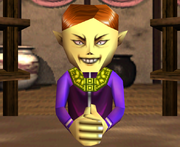
of his eyes. However, when he opens them during one of his violent outbursts, they are red. Red eyes are a characteristic commonly connected to the Sheikah. However, the red eye color may stem from the fact that the eyes are bloodshot during his frantic episodes. Additionally, in Ocarina of Time, the Happy Mask Salesman gives Link the Mask of Truth as a reward for selling his masks. The Mask of Truth is a well-known artifact of the Sheikah race. It could be that he somehow obtained the mask during his travels, but it could also have been passed down to him by his would-be ancestors, the Sheikah.
While non-canonical, in the manga, the Happy Mask Salesman's eyes are occasionally open, but since the manga is printed in black and white, it is impossible to determine the eye color. However, the brightness of the irises suggests that the color is a light color, obviously ruling red out, unless it is a lighter shade of red.
Shigeru Miyamoto[]
Another belief is that the Happy Mask Salesman is an in-game avatar of Shigeru Miyamoto, the creator of the Mario series and the Legend of Zelda series. This theory is compounded by his seemingly unlimited knowledge, strange powers, and the appearance of masks resembling Mario and King Dedede, both of which are Nintendo characters. Additionally, Shigeru Miyamoto has stated that as a child, he had dreamed of directing puppet shows before getting into gaming. This could be a further reference to the Happy Mask Salesman, who, in the game, seems to be influencing all of the events from behind the scenes.
Bunny Hood[]
The Bunny Hood (ウサギずきん, Usagi Zukin?) is a recurring mask in the Legend of Zelda series. As its name suggests,
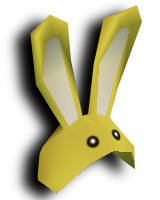
Bunny Hood
the mask resembles the upper head of a rabbit, including the eyes and ears. The ears will flop around due to a "jiggle-bone" program when Link walks or perform most other movements such as using the sword and/or jumping.
Pols Voice[]
The Bunny Hood bears a resemblance to a Pols Voice, a recurring enemy in the series. This may not be a coincidence, however; when Link sells the Bunny Hood to the Running Man in Ocarina of Time, he states upon receiving the mask, "I bet with those long ears you can hear the voices." This quote may very well indicate a connection between the Bunny Hood and the Pols Voice. The Bunny Hood itself may simply be a reference to The Legend of Zelda: A Link to the Past, in which Link becomes a bunny in the Dark World before obtaining the Moon Pearl.
Star Fox[]
The Bunny Hood is believed to be a reference to Peppy Hare, an anthropomorphic hare from the Star Fox series. Peppy is a decidedly positive and optimistic character, similar to Grog's attitude before presenting Link with the Bunny Hood. It is one of five masks that are a supposed reference to Star Fox, along with the Bremen Mask, Don Gero's Mask, the Keaton Mask, and the Mask of Scents.
Butterflies[]
Butterflies turning into fairies through player interaction may be a reference to Super Mario 64, in which

Butterflies
butterflies turn into 1-up Mushrooms (or, occasionally, explosive bombs) when Mario punches or kicks at a swarm of butterflies.
Composer Brothers[]
The Composer Brothers may be based on Mario and Luigi, another pair of

Flat

Sharp
siblings of Nintendo. This is supported by the fact that Sharp is the elder brother, short, somewhat wide, and wears red, which is similar to Mario, and Flat is the younger brother, tall, thin, and wears green, which is similar to Luigi; additionally, the Composer Brothers both have mustaches, as do Mario and Luigi. Furthermore, the inscriptions on their gravestones read "Royal Composer Bros."; this truncated form of "brothers" may be a reference to Super Mario Bros.
Princess Zelda[]
The relationship Zelda has with Link is close, possibly her closest. A popular theory among
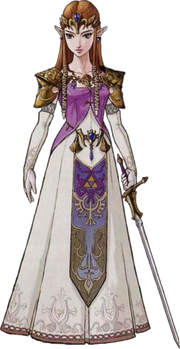
fans is that of a romantic relationship between some of the Zelda and Link characters in the Zelda series. Although never explicitly confirmed in a video game title, this theory is based on hints given in the games, interviews with the game creators, and content of the animated series, comics, and manga (although the last three are generally considered non-canonical).
One hint of a romance between Zelda and Link is given at the end of The Adventure of Link, when the awakened Princess apparently kisses Link under the falling curtain.
Some cutscenes in Ocarina of Time featuring the two together have been interpreted as signs of an attraction. While Link and Zelda are escaping Ganon's Castle, Zelda will additionally show her concern for Link by shouting out whenever he is hurt. Moreover, in the game's final scene, Zelda and Link are floating in the sky together, sharing a decidedly sentimental (if not necessarily romantic) moment where Zelda apologies for involving Link in the events of the game and seems saddened by the situation. She also stated that she will not forget the time she spent with him in the Child Timeline as shown in Majora's Mask through Link's memory.
In addition, if the Oracle games are played as sequels to each other, the ultimate ending sequence shows Zelda lightly kissing Link on the cheek. Link swoons while hearts float above the pair's heads, and Zelda looks away, blushing. In The Wind Waker, when Zelda is asked to stay in hiding in Hyrule Castle while Link restores power to the Master Sword, she waves goodbye to Link, asking him to be careful.
Spirit Tracks features several moments that can be interpreted romantically. Early in the game
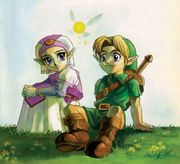
during the Graduation Ceremony, Zelda walks into the room in front of Link, who is bowing down respectfully. Link then looks up and gasps, blushing at her in amazement. He is then scolded by Chancellor Cole for raising his head without permission. Later, when Zelda's spirit is separated from her body following the first encounter with Chancellor Cole and Byrne, Link is the only one who can see her besides the Lokomos, demonstrating a clear and strong bond between himself and the Princess. After Zelda and Link defeat Byrne in the Tower of Spirits, Byrne, disbelieving, comments that he was beaten by two humans. Zelda, while still possessing a Phantom, says that when she and Link combine their strength, no one can defeat them. Link turns to her, surprised. The background turns white and Zelda's Lullaby plays as they both laugh and high-five, gazing at each other all the while. Toward the end of the game, before the final battle against Malladus, Zelda is reunited with her body, and is no longer able to levitate. Link runs underneath her to catch her as she falls, and she lands on top of him and knocks them both to the ground as well as knock Link out for a few seconds. Upon awakening, Zelda, overjoyed to have her body back, embraces Link, causing him to blush. Finally, after Malladus is defeated, Zelda and Link watch Anjean and Byrne's spirits ascend to the heavens. The camera then lowers to show Zelda and Link holding hands while Zelda's Lullaby plays in the background. After the credits, a short cut scene shows Zelda gazing at a picture of Link on the Spirit Train with her flying beside him, which she keeps on her desk. she may also wave at Link depending on his answer to a question Zelda asked before.
Skyward Sword has several noticeable romantic moments between Link and Zelda. Early in the game, Zelda wants Link to be the first to see her outfit for the Wing Ceremony. She worries over him and she does not want him to fail at becoming a knight. When Link's Crimson Loftwing is hidden by Groose, Zelda assists Link in finding his Loftwing. After Link wins the Wing Ceremony, Zelda jumps off the ledge and Link catches her almost as if she was expecting him to. She then congratulates him on winning. Afterwards, Zelda mentions that she is very happy to be atop the Statue of the Goddess with him. She also gets extremely close to him and almost implies that the two are to kiss, before she pushes him off the statue. Afterward, Zelda bashfully asks Link to go out flying which they do. She then tells Link how amazing the day was, and that she would remember it forever. At the Temple of Hylia, when Zelda states she must seal herself to keep Demise in place, she sheds tears of sadness and states before all this, she was happy just being with Link on Skyloft, demonstrating a deep level of feelings for Link. Link desperately tries to stop her and when she is sealed, Link lowers his head in sadness, showing his deep feelings for her. Much later in the game, when Link releases Zelda from her sealed state, Link runs up and catches her from falling and both of them hug and walk out smiling at each other, holding hands, before Ghirahim ruins the tender moment. During the ending, Zelda asks what Link will do now. Link sweetly smiles at her while their Loftwings fly off toward the sky, implying that he chose to stay on the Surface to live with Zelda.
A Link Between Worlds features some gossip told to Link by the Rumor Guy. He tells Link that one of the castle staff had seen Zelda sneaking off every night. When she followed her, she saw Zelda staring at the painting in Hyrule Castle depicting the Link and Zelda from A Link to the Past cuddling with each other, implying they became more intimate with each other. This also hints the Zelda in A Link Between Worlds wants to have a similar relationship with the Link of her time.
The game creators also seem to be fond of the idea of romance between the characters.[1]
Though never directly stated in-game, Shigeru Miyamoto revealed in an interview conducted by Famimaga 64 that Navi is jealous of Princess Zelda and has feelings for Link.[2]
Another less popular theory among fans is that Link and Zelda are related by blood, either as siblings or more distantly. Even though rumors to this effect started with the infamous "Save the Princess... Zelda is your... ... ..." line from A Link to the Past (later reported as a mistranslation), the theory generally revolves around the Link and Zelda from Ocarina of Time.
A possible indication of a blood relation between the two in Ocarina of Time is their physical resemblance: they both have blonde hair, blue eyes, and similar facial features. They also have similarly shaped heads. Graphics limitations could be responsible for some of this similarity, however. Certain dialogue could also be perceived as implying a blood relation: the ghost Sharp comments that Link reminds him of Zelda, and that Link "may have some connection with the Royal Family".[3] Link's connection to the Royal Family is highlighted throughout the game, with Link often playing Zelda's Lullaby to verify it. The fact that Impa agrees to teach a strange boy a song only Royal Family members are allowed to know could also be interpreted as a hint at Link's blood relation to Hyrule's Royal Family. [4]
Additionally, Zelda seems to recognize Link's name upon their first meeting.[5] This could be attributed to her prophetic abilities, although the boy in her dreams seemed to be a largely abstract figure, with no defining traits aside from the presence of a guardian Fairy and a Spiritual Stone. This line of dialogue has often been regarded as a sign that the two have met before, although this could only have occurred when Link was a baby per the Deku Tree Sprout's account of Link's coming to Kokiri Forest. It is also worth noting that while the King of Hyrule is clearly identified as Zelda's father, no mention is made of a Queen. Meanwhile, Link's mother is stated to have died shortly after reaching the forest, but no information is given concerning his father. Given these facts, it is possible that Zelda and Link share the same parents, making them siblings.
ReDead[]
"During Ganondorf's dark reign, many evil beings walked the earth, but none were as horrible as
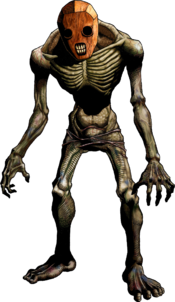
the ReDead. These skeletal creatures froze people who strayed too close, then they sucked the life from the unfortunate victims."
— Nintendo Power Player's Guide description ReDeads (リーデッド Rīdeddo?) are recurring enemies in the Legend of Zelda series. They are highly emaciated, undead humanoid creatures, closely resembling zombies. They are found in dark and distant locations such as Hidden Holes and dungeons. ReDeads are capable of completely halting the movement of their prey with their gaze when they come close; concurrently, they emit blood-curdling screams to terrify their unfortunate victim. They will then close in on their stunned victim, and in most games will attach to them to drain their life energy. ReDeads are considered to be among the most frightening enemies of the Legend of Zelda series.
Origin[]
It is possible that ReDeads were once regular, deceased Hylians who happened to be re-animated through exposure to dark magic, or that they are, like Poes, restless spirits wandering the world of the living. Considering the abundance of ReDeads found in the devastated Hyrule Castle Town of the future, as well as underneath the Kakariko Graveyard and inside the Shadow Temple, this theory seems plausible.
Burial Customs[]
The differences in appearance and habits between the different incarnations of ReDeads may suggest changes in burial customs over the passing of time. ReDeads found in Ocarina of Time and Majora's Mask are sometimes encountered underneath graves, and appear to be wearing carved Spooky Masks over their faces. ReDeads found in The Wind Waker are decidedly teal-colored. Since these corpses were all buried below sea level, it is possible they were punished for evil doings, and forced to haunt Hyrule forever.
Split Timeline[]
It is speculated by some that alternate worlds such as the Twilight Realm and Termina may be unaffected by the timeline split. However, while these two realms are alternate dimensions, there is no evidence to support the idea that they exist outside of linear time. Both realms have demonstrated the ability to receive beings from the Child Timeline and return them to the Child Timeline when they exit back into Hyrule. There is no reason to believe that these two realms would only exist as a single timeline, or that they could "prioritize" inputs from one timeline, and later output these into both the timelines.
In addition, the renowned Youtube show, Game Theory, dismissed the Zelda Timeline, particularly the Defeat Timeline (in where Link fails on his quest) on the grounds that "the hero cannot be simultaneously victorious and defeated". Elaborating, he explained that with Link defeating Gannondorf, two perfectly possible timelines are created; However if Link dies at any point in his journey another separate timeline is created. Explaining that the only way for all 3 timelines to exist is the Many Worlds Theory (the theory that all possible pasts and futures exist in separate timelines). [1]
Stalchild[]
It is possible that the Stalchildren of Ocarina of Time are Kokiri who have left the Kokiri
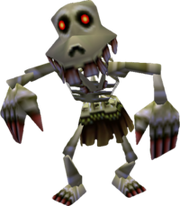
Forest, thus turning into Stalchildren. They could also be Hylians who are suffering the effects of the Lost Woods, with a Stalchild being an intermediary stage between a Hylian and a Stalfos. However, since the Stalfos transformation is supposedly imposed on those unable to find their way out of the Lost Woods, it seems unlikely that such individuals would appear in Hyrule Field. Additionally, Kokiri are seen outside the Forest during the end credits of Ocarina of Time, suggesting that their law of "Those who leave the forest will die" is simply a warning of the dangers posed by the outside world.
